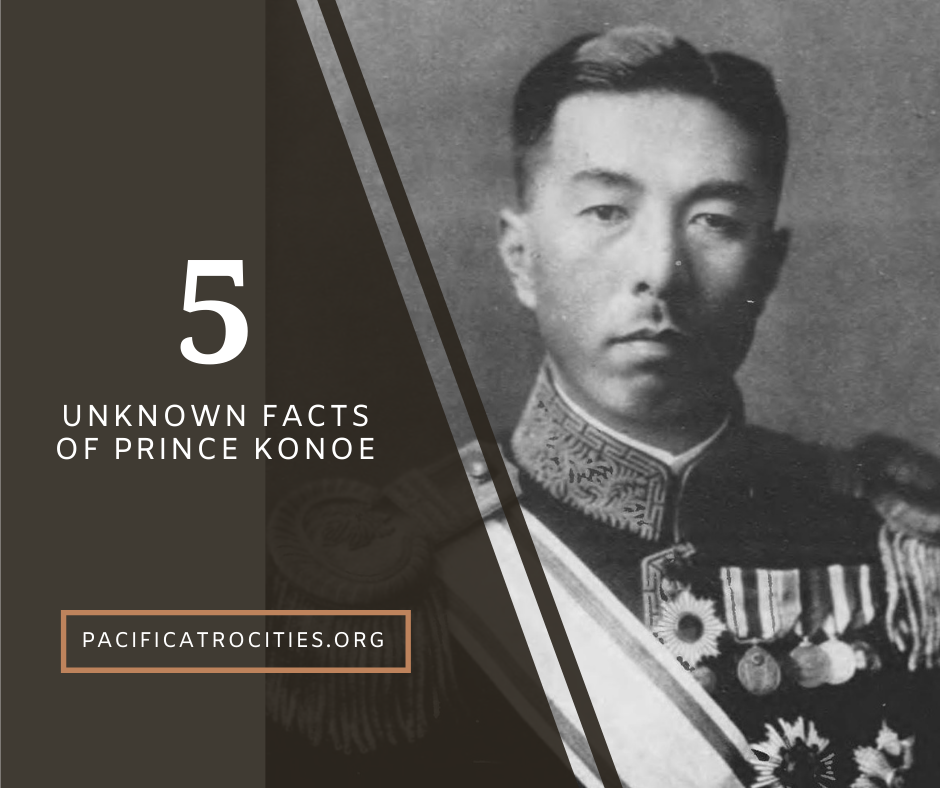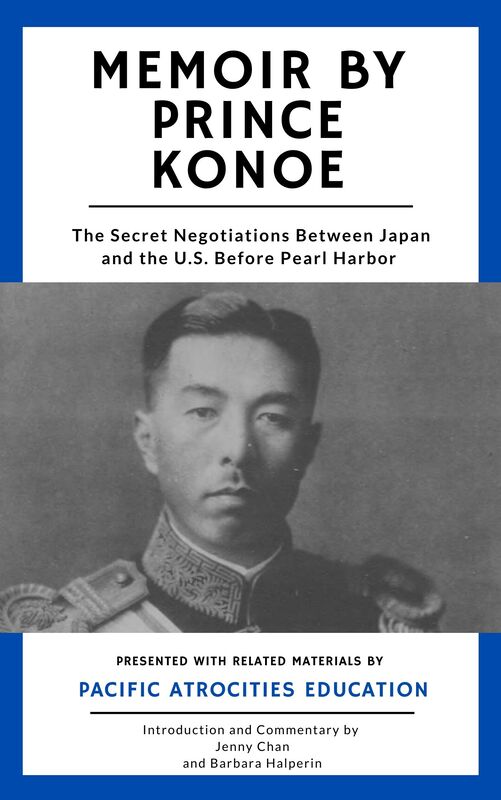|
by Ren Ke Prominent Konoe family Prince Konoe, also known as Fumimaro Konoe, is one of the main branches of the ancient Fujiwara clan. Fumimaro Konoe was born in Tokyo on October 12, 1891, to the prominent Konoe family, one of the five regent houses. Prince Konoe is the eldest son of Duke Atsumaro Konoe. Thus, in1904 (Meiji 37), 12-year-old Fumaki Kanei inherited the title after the death of his father, Duke Konoe. In 1916 (5th year of Taisho), according to the Noble House Order and Prince Konoe's aristocratic status, he entered the House of Noble as a Duke Member and started his political career at the age of 25. Five Regent House? The Five Regent Houses is a collective term for the five families of the main branches of the ancient Fujiwara clan. The five houses are Konoe, Takatsukasa, Kujō, Ichijō, and Nijō. The leaders of these families monopolized the position of Sekkan in the Japanese Imperial Court in Kyoto between the 12th and 19th century. They were the most politically powerful families among the kuge (court). Prime Minister Konoe's First Declaration In June 1937, Prince Konoe became the Prime Minister of the Cabinet for the first time. During his tenure, he issued the three famous declarations. Prime Minister Konoe's First Declaration, the well-known statement of "not taking the Chinese national government as an opponent," was issued on January 16, 1938. "Afterwards, the imperial government will not use the national government as its opponent but expects the establishment and development of a new Chinese regime that can truly cooperate with the empire, and will adjust the relations between the two countries with this new regime." Before this statement, the Japanese army was advancing extremely fast in aggression in China and pursuing the policy of sukusen sokketsu 速戦即決, which translates to rapid warfare. The Japanese government even clamored to end the war in three months, and the Chinese National Government's capital Nanjing was broken on December 13, 1937. At that time, Japan was confident about its advantages in the war against China. At this time, Prince Konoe had no intention of a truce but attempted to ultimately defeat China. Under this circumstance, Prince Konoe made such a statement. However, from the perspective of historical development, this statement shackled the flexibility of the Japanese government's policy toward China. What happened in China before the National Government's capital Nanjing fell on December 13, 1937? The Marco Polo Bridge Incident: also known as the Lugou Bridge Incident, was a July 1937 battle between China's National Revolutionary Army and the Imperial Japanese Army. The Marco Polo Bridge Incident is generally reckoned as the start of the Second Sino-Japanese War. The August 13 Incident: also known as the "Second Shanghai Incident," occurred on August 13, 1937. On August 14, the Chinese Nationalist Government issued the "Declaration of Self-Defense and Resistance," announcing that the 3-month-long Battle of Shanghai was officially launched. A total of 98,000 Japanese troops were killed and injured during the Battle of Shanghai. This incident manifested that the Japanese government's goal of succeeding in the occupation of China within three months failed. Establishment of Taisei Yokusankai Prince Konoe was one of the founders of Taisei Yokusankai(大政翼賛会). On July 22, 1940, Prince Konoe served as Prime Minister of Japan for the second time. As the first Japanese politician to publicly support Nazi Germany, on July 26, Konoe imitated the Nazi party model formed by Hitler and intended to dissolve other political parties in the name of the "Basic National Policy Outline." He then launched the "New System Movement," prompting Taisei Yokusankai to become a one-party dictatorship Fascist party. On September 27, Germany, Italy, and Japan signed the "Triple Alliance Treaty" and formed the Berlin-Rome-Tokyo Axis. The establishment of Taisei Yokusankai was to promote the "new system movement" of concentrated political power, dissolve the existing political parties into a national political organization, and rule Japan in a one-party dictatorship model. However, Taisei Yokusankai was dissolved in June 1945 and merged into the "Volunteer Fighting Corps" established in response to the decisive local battle, which disbanded after Japan surrendered. "Class-A War Criminal" After Japan's surrender, Prince Konoe still had some hope of avoiding trials, feeling that if he had been ruling the country for many years, the Allied forces would have had to rely on him. Indeed, when the allied forces entered Japan, the Allied General Command asked him for many favors, but the trial of war criminals was on schedule as the situation stabilized. In 1945, the International Prosecutors Office (IPS) issued Prince Konoe an additional arrest warrant. When Konoe heard the news that he was about to be prosecuted, he committed suicide by taking potassium cyanide before being arrested on December 16, 1945, to avoid trial. Therefore, Prince Konoe was a Japanese "Class A War Criminal" in World War II. The quotation marks indicate that a court has not tried him. In this case, he is not legally but an inevitable war criminal in people's minds. Grandfather of the Prime Minister Morihiro Hosokawa (細川護煕) is Prince Konoe's grandson. Hosokawa was born in 1938. He was the Prime Minister of Japan from 1993 to 1994, leading a coalition government that was Japan's first non-Liberal Democratic Party (LDP) government since 1955. However, Hosokawa only served as the prime minister for 8 months. In April 1994, the Hosokawa cabinet fell. Hosokawa joined the Democratic Party in 1998. Hosokawa has been, since 2005, the head of the Kumamoto-Hosokawa clan, one of the noble families of Japan. Reference: 人民网. (n.d.). 八一三事变. 人民网. https://web.archive.org/web/20160304083708/http://dangshi.people.com.cn/BIG5/165617/166495/168107/10002233.html. 近卫文麻郎: 日本首相 - 政治、法律和政府: 七月 2021. gov. (n.d.). https://zh.gov-civ-guarda.pt/konoe-fumimaro. 近衛声明. アジア歴史資料センター. (n.d.). https://www.jacar.go.jp/topicsfromjacar/02_persons/index02_006.html. Berger, G. (1974). Japan's Young Prince. Konoe Fumimaro's Early Political Career, 1916-1931. Monumenta Nipponica,29(4), 451-475. doi:10.2307/2383896 Jansen, M. (1988). Journal of Japanese Studies, 14(2), 457-468. doi:10.2307/132617 Chen, F. (2019, January 9). 戰雲下厲行皇民化 台日文學社團相互較勁【民視台灣學堂】台灣新文學史 2019.1.10-陳芳明. YouTube. https://youtu.be/Q2PzZLu6Qmw. Facing, H. (n.d.). War criminals and aggressive war. Facing History and Ourselves. https://www.facinghistory.org/nanjing-atrocities/judgment-memory-legacy/war-criminals-and-aggressive-war. Lei, G. (2018, November 3). 抗战时期"近卫声明"的来龙去脉_日本政府. https://www.sohu.com/a/272848929_166075. Learn more
0 Comments
Leave a Reply. |
- Home
- Stories
-
Internship
- Summer 2024 Internship
- Summer 2023 Internship
- Fall 2022 Internship
- Summer 2022 Internship
- Summer 2021 Internship
- Fall 2020- Spring 2021 Internship
- Summer 2020 Internship
- Fall 2019 Internship
- Summer 2019 Internship >
- School Year 2018-2019 Internship
- Summer 2018 Internship >
- Fall 2017 Internship
- Summer 2017 Internship >
- Books
- Archives
-
Resource Page
-
Supplementary Research Guides
>
- Unit 731 - Guide >
-
Philippines' Resistance - Guide
>
- Philippines World War II Timeline
- The Japanese Invasion & Conquest of the Philippines
- Bataan Death March
- Formation of Underground Philippines Resistance
- Supplies of the Guerrilla Fighters
- The Hukbalahap
- Hunter's ROTC
- Marking's Guerrillas
- United States Army Forces in the Philippines of Northern Luzon (USAFIP-NL)
- The Aetas
- Chinese and Filipino-Chinese Nationalist Guerrilla Units
- The Female Faces of the Philippine Guerrillas
- Rising Sun Flag - Guide >
- Pinay Guerrilleras - Guide >
- Fall of Singapore - Guide >
- Three Years and Eight Months - Guide >
- Siamese Sovereignty - Guide >
- The Khabarovsk War Crimes Trial - Guide >
- Unit 731 Cover-up : The Operation Paperclip of the East - Guide >
- Marutas of Unit 731 - Guide >
- Prince Konoe Memoir - Guide >
- Competing Empires in Burma - Guide >
- Battle of Shanghai - Guide >
- Ishi Shiro - Guide >
- Taiwan The Israel of the East - Guide >
- Seeking Justice for Biological Warfare Victims of Unit 731 - Guide >
- Rice and Revolution - Guide >
- Clash of Empires - Guide >
-
Hunger for Power and Self-SufficiencyI - Guide
>
- The Influence of War Rations on Post-War Culinary Transformations
- How World War II Complicated Food Scarcity and Invention
- American Military Innovations
- Government-Sponsored Food Inventions in Europe during World War II
- Feeding the Army: The Adaptation of Japanese Military Cuisine and Its Impact on the Philippines
- Mixed Dishes: Culinary Innovations Driven by Necessity and Food Scarcity
-
Denial A Quick Look of History of Comfort Women and Present Days’ Complication - Guide
>
- The Comfort Women System and the Fight for Recognition
- The Role of Activism and International Pressure
- The Controversy over Japanese History Textbooks
- The Sonyŏsang Statue and the Symbolism of Public Memorials
- Activism and Support from Japanese Citizens
- The Future of Comfort Women Memorials and Education
- Echoes of Empire: The Power of Japanese Propaganda - Guide >
- Lesson Plans >
-
Supplementary Research Guides
>
|
Pacific Atrocities Education
730 Commercial Street San Francisco, CA 94108 415-988-9889 |
Copyright © 2021 Pacific Atrocities Education.
We are a registered 501 (c)(3) charity. |
- Home
- Stories
-
Internship
- Summer 2024 Internship
- Summer 2023 Internship
- Fall 2022 Internship
- Summer 2022 Internship
- Summer 2021 Internship
- Fall 2020- Spring 2021 Internship
- Summer 2020 Internship
- Fall 2019 Internship
- Summer 2019 Internship >
- School Year 2018-2019 Internship
- Summer 2018 Internship >
- Fall 2017 Internship
- Summer 2017 Internship >
- Books
- Archives
-
Resource Page
-
Supplementary Research Guides
>
- Unit 731 - Guide >
-
Philippines' Resistance - Guide
>
- Philippines World War II Timeline
- The Japanese Invasion & Conquest of the Philippines
- Bataan Death March
- Formation of Underground Philippines Resistance
- Supplies of the Guerrilla Fighters
- The Hukbalahap
- Hunter's ROTC
- Marking's Guerrillas
- United States Army Forces in the Philippines of Northern Luzon (USAFIP-NL)
- The Aetas
- Chinese and Filipino-Chinese Nationalist Guerrilla Units
- The Female Faces of the Philippine Guerrillas
- Rising Sun Flag - Guide >
- Pinay Guerrilleras - Guide >
- Fall of Singapore - Guide >
- Three Years and Eight Months - Guide >
- Siamese Sovereignty - Guide >
- The Khabarovsk War Crimes Trial - Guide >
- Unit 731 Cover-up : The Operation Paperclip of the East - Guide >
- Marutas of Unit 731 - Guide >
- Prince Konoe Memoir - Guide >
- Competing Empires in Burma - Guide >
- Battle of Shanghai - Guide >
- Ishi Shiro - Guide >
- Taiwan The Israel of the East - Guide >
- Seeking Justice for Biological Warfare Victims of Unit 731 - Guide >
- Rice and Revolution - Guide >
- Clash of Empires - Guide >
-
Hunger for Power and Self-SufficiencyI - Guide
>
- The Influence of War Rations on Post-War Culinary Transformations
- How World War II Complicated Food Scarcity and Invention
- American Military Innovations
- Government-Sponsored Food Inventions in Europe during World War II
- Feeding the Army: The Adaptation of Japanese Military Cuisine and Its Impact on the Philippines
- Mixed Dishes: Culinary Innovations Driven by Necessity and Food Scarcity
-
Denial A Quick Look of History of Comfort Women and Present Days’ Complication - Guide
>
- The Comfort Women System and the Fight for Recognition
- The Role of Activism and International Pressure
- The Controversy over Japanese History Textbooks
- The Sonyŏsang Statue and the Symbolism of Public Memorials
- Activism and Support from Japanese Citizens
- The Future of Comfort Women Memorials and Education
- Echoes of Empire: The Power of Japanese Propaganda - Guide >
- Lesson Plans >
-
Supplementary Research Guides
>

